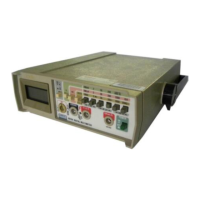MAINTENANCE
PERFORMANCE
TEST
4-27.
PERFORMANCE
TEST
4-28. The performance test compares the
performance
of
your
Multimeter with the list of
specifications given
in
Section
1. This test is recommended
for incoming
inspection,
as a
preventive maintenance
check, and to
verify
the specifications. If the instrument fails any part of
the
performance test, calibration and/or repair
is
indicated.
4-29.
Allow
the
instrument
to stabilize and
perform
the
test
at an ambient temperature of 23°C +5°C
(73°
F
±9°F).
During the performance test (and the calibration
procedure)
your
Multimeter is
referred
to as
the
UUT
(Unit
Under Test).
4-30.
Display Test
4-31.
Use the following procedure to verify
the
proper
operation of the LCD;
1. On the UUT, set the POWER switch to the
ON
position.
2.
On
the
UUT,
select the kH function,
2000
kfl
range.
Verify that
the
overrange
indication
(1)
appears
on
the LCD.
3. On
the
UUT, select the V DC function. Verify a
display reading of
“000”.
4. Connect the Low
Ohms
Calibration
Lead
between the V/kO/S and COMMON input
terminals.
5. Refer to Table
4-2,
verify the proper position of
the decimal point
for
each range shown.
6. Remove the Low Ohms Calibration Lead.
7. Connect the HI output ofthe DMM Calibrator
to
the V/kD/S
input of
the
UUT. Connect the
LO
output
of
the
DMM
Calibrator
to the
COMMON input
termmal
of
the
UUT.
Table
4-2.
Display
Test
RANGE
DISPLAY
READING
200 mV
00.0
2V
20V
200V 00.0
1000V 000
10A/20 IVIf2
0.00
. .....
8. On the UUT, select the
DC
V
function, 20V
range.
9.
Set the DMM Calibrator
for an
output of
-18.88V dc.
Verify
that
all segments
of the
digits are illuminated.
4-32.
Resistance/Conducta
nee
Test
4-33.
Use the following procedure to verify
the proper
operation and performance
of the
resistance
and
conductance ranges:
1.
On
the UUT, connect
the Low
Ohms
Calibration
Lead between the
V/kfl/S
and
COMMON
input
terminals.
2. On
the
UUT, select the
kH function,
2000
range. Verify that the
display reading
is
between
“00.0”
and
“00.2”.
3.
Remove the
Low Ohms Calibration
Lead.
4. On
the
UUT,
select
the
S
function
200 nS range.
Verify that the
display
reading
is
between
“00.0”
and
“01.0”.
5. Connect the HI output
of the DMM
Calibrator
to
the V/kO/S
input terminal
of the
UUT.
Connect the
LO
output of the
Multimeter
Calibrator to the
COMMON input
terminal
of
the UUT.
6. For each step in
Table 4-3, select
the
range
shown and
adjust the
DMM
Calibrator
to the
required
UUT resistance
input,
then verify
that
the UUT display reading
is within
limits.
Table
4-3.
Resistance/Conductance Test
STEP
RANGE
UUT INPUT
DISPLAY READING
1
200Q ^ooa
99.7 to 100.3
1
ka 997 to 1003
20 ka 10kf2
9.97
to
10.03
200 kQ 100 k£2
99.7
to
100.3
2000
kn 1 MQ, 994 to 1006
20 9.94 to 10.06
2 mS 1
kn
0.997 to
1.003
20jliS
100
9.97 to 10.03
200 nS
10 Mn
98.0 to 102.0
10
2
mS
OPEN
.000
11
20
}iS
OPEN
0.00
12
200
nS OPEN
00.0
4-5

